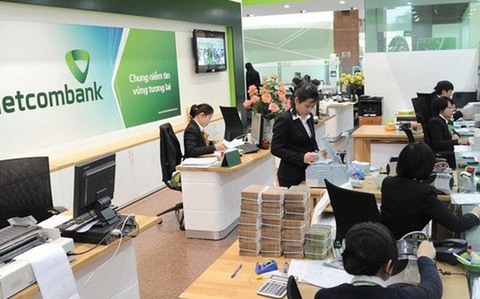 Economy
Economy

The State Bank of Việt Nam (SBV) is planning to change its policy on reserve requirement ratios for credit institutions and foreign banks' branches for the first time since 2011.
 |
| Vietcombank can be the beneficiary of the proposed reserve requirement policy as it has so far taken part in the restructuring of ailing CB Bank. - Photo VCB |
HÀ NỘI – The State Bank of Việt Nam (SBV) is planning to change its policy on reserve requirement ratios for credit institutions and foreign banks’ branches for the first time since 2011.
The plan has put forward for comment.
The SBV will reduce the reserve requirement ratio by half for credit institutions that take part in the central bank’s plans to support the restructuring of ailing credit institutions.
The reserve ratio is the portion of reservable liabilities that depository institutions must hold onto, rather than lend out or invest. Currently, the SBV’s reserve requirement ratio applicable to demand and below 12-month term deposits is 3 per cent of the total deposits, while the rate for 12-month-plus term deposits is 1 per cent. The ratios for foreign currency deposits are 8 per cent and 6 per cent, respectively.
The above rates have remained unchanged since 2011.
According to the central bank, the draft policy was aimed to implement the revised Law on Credit Institutions.
Experts said the move was aimed at encouraging banks to take part in the restructuring of ailing credit institutions as the reduction of the reserve requirement ratio would help them have more cheap capital sources for business activities.
Banking expert Nguyễn Trí Hiếu said if the reserve requirement ratio was reduced, costs would decrease, thereby increasing the lending capacity and deposit expansion coefficient of credit institutions.
However, the new policy would contribute to increasing finances, causing the central bank difficulties in controlling the liquidity of the banking system and inflation.
To minimise the adverse impacts, banking expert Phan Minh Ngọc suggested the central bank should limit the simultaneous use of other preferential instruments, such as refinancing loans with zero per cent interest rates, for credit institutions that supported the restructuring of ailing credit institutions.
Some banks, including Vietcombank, VietinBank and BIDV have participated in the restructuring of DongA Bank, CB Bank, Ocean Bank and GP Bank.
According to the central bank, after years of major restructuring in the banking system, eight credit institutions have disappeared from the market: MDBank, MHB, DaiABank, Ficombank, TinNghiaBank, SouthernBank, WesternBank and Habubank.
In the past year, with improvement in legal frameworks for restructuring credit institutions and dealing with bad debts, such as the issue of Resolution No 42/2017/QH14 by the National Assembly and the amended Law on Credit Institutions, the banking industry has ramped up the restructuring of ailing credit institutions and dealt with non-performing loans (NPLs).
Credit institutions settled VNĐ149.22 trillion (US$6.37 billion) of NPLs last year, helping reduce the NPL ratio of the entire banking system to 1.89 per cent by the end of 2018 against 1.99 per cent by the end of 2017.
By the end of 2018, total assets of credit institutions reached VNĐ10.91 quadrillion, up 9.17 per cent against the previous year. Their capital adequacy ratio also improved at 12.08 per cent on average. – VNS

.jpeg)


